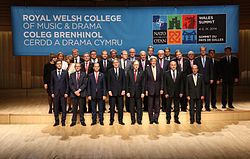A request that this article title be changed to 2014 NATO summit is under discussion . Please do not move this article until the discussion is closed. |
| NATO Summit Wales 2014 2014 Newport Summit | |
|---|---|
 Logo of the 2014 Wales Summit | |
| Host country | United Kingdom |
| Date | 4–5 September 2014 |
| Venue(s) | Celtic Manor, Newport |
| Cities | Newport, Cardiff |
| Website | NATO Summit Wales 2014 |

The 2014 Wales Summit of the North Atlantic Treaty Organization (NATO) was the 25th summit of the heads of state and heads of government of the NATO countries, held in Newport, Wales on 4 and 5 September 2014. Such summits are sporadically held and allow leaders and officials from NATO Allies to discuss current issues of mutual concern and to plan strategic activities. The 2014 summit has been described by US Navy Admiral James G. Stavridis as the most important since the fall of the Berlin Wall. [1]
Contents
- Background
- Agenda
- Outcomes
- Russia and Ukraine
- Wales Pledge
- Support for Military Intervention Against ISIL
- Joint Expeditionary Force (FNC/UK)
- Criticism
- Protestors and security detail
- Leaders and other dignitaries in attendance
- Member states
- Non-member states and organisations
- NATO Foreign ministers
- See also
- References
- External links




